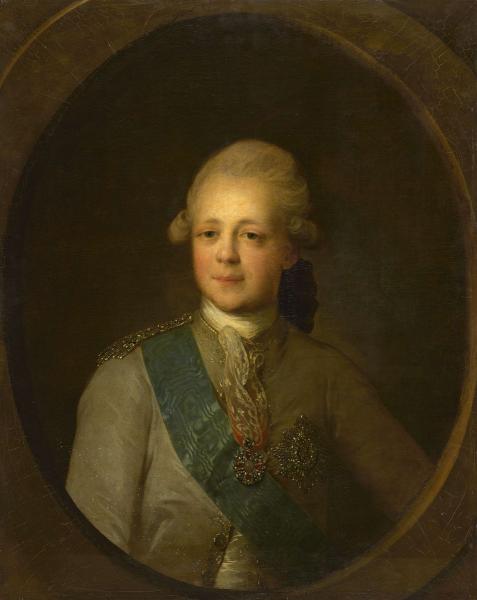The artist is Rokotov

+ Virtual excursion &Laquyagilev. START&Raquo >>>
– Hide the text of a virtual tour &Laquyagilev. START&Raquo
The second portrait is more official and restrained. The boy grew up, became a young man who was fully aware of his high position of the heir to the tsarist throne. However, here is also a strong charm of a unique “Rokotov” picturesque manner. The model, as it were, protrudes from the shimmering dusk, the features of the illuminated face are slightly blurry, as if shrouded in a haze. A portrait that seems almost monochrome, nevertheless, plays a wealth of exquisite color combinations. Soft, muffled tones create an atmosphere of intimacy, where there is nothing ostentatious, outwardly spectacular.
E.AT.Amphilokhiev, e.AT.Stankevich and N.AND.Fedorova. Materials for a virtual tour of the exhibition "Diaghilev. Start". 2009
Go to the beginning of the virtual tour “Diaghilev. START”
Pavel I Petrovich (September 20 / October 1, 1754, St. Petersburg − March 12/24, 1801, St. Petersburg) − The son of Grand Duke Peter Fedorovich (Peter III) and Grand Duchess Ekaterina Alekseevna (Catherine II). Emperor All -Russian, Grand Master of the Maltese Order. Killed as a result of a noble conspiracy. Reigned from November 6/17, 1796 to 12/24 March 1801.
The 400th anniversary of the Romanov house. SPb, 2013. With. 112.
Grand Duke Pavel Petrovich (1754 – 1801) – son of Grand Duke Pyotr Fedorovich, future emperor Peter and Grand Duchess Ekaterina Alekseevna, future Empress Catherine II. Since 1796 – Russian Emperor. Killed in 1801 as a result of a noble conspiracy in the Mikhailovsky castle in St. Petersburg.
Reviews of contemporaries about the appearance of Paul were diametrically opposite. The more interesting the visual range of its portraits, performed by the largest portraitists of the second half of the 18th century. F. With. Rokotov performed several portraits of the heir to Tsarevich Pavel Petrovich. This portrait was created when Pavel was about seventeen years old. In it, as in other works of the artist, the same charm of the unique “Rokotovsky” picturesque manner and interpretation of the image.
The model, as it were, protrudes from the shimmering dusk, the features of the illuminated face are slightly blurry, as if shrouded in a haze. A portrait that seems almost monochrome, however, is characterized by wealth and sophistication of color combinations. Soft, muffled tones create an atmosphere of intimacy, where there is nothing ostentatious, outwardly spectacular. The lyrical mood does not violate the accurately depicted official regalia – the highest award of the Russian Empire Order of St. Andrew the First -Called (the blue tape over the shoulder and the star strengthened by diamonds) and the cross of the Order of St. Anna.
The portrait for a long time was in the Romanov Gallery of the Winter Palace, and in the 1920s was transferred from the Hermitage to the Russian Museum.
Leave a Reply